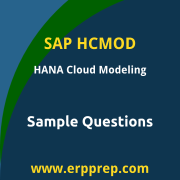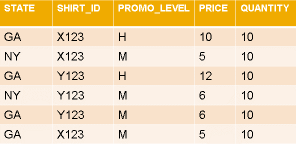 The SAP HANA Cloud Modeling Certification Sample Question Set is prepared to make you familiar with actual SAP C_HCMOD_05 exam question format and exam pattern. To get familiar with more exam properties, we suggest you to try our Sample SAP HANA Cloud Modeling Certification Practice Exam.
The SAP HANA Cloud Modeling Certification Sample Question Set is prepared to make you familiar with actual SAP C_HCMOD_05 exam question format and exam pattern. To get familiar with more exam properties, we suggest you to try our Sample SAP HANA Cloud Modeling Certification Practice Exam.
This Sample SAP HCMOD Certification Practice Exam is designed for evaluation purpose only. If you are planning to write the SAP HANA Cloud Modeling Certification Exam (C_HCMOD_05) and really want to test your SAP HANA Cloud Modeling subject knowledge to identify your weak areas, we strongly recommend you to start your preparation with our Premium SAP HANA Cloud Modeling Certification Practice Exam.
SAP HANA Cloud Modeling Sample Questions:
01. What can you discover using Data Lineage?
Please choose the correct answer.
a) Data changes since last refresh
b) Frequency of load
c) Underlying calculation views and tables
d) Access statistics
02. Which of the following are types of calculation view can you create in SAP HANA Cloud?
There are 2 correct answers to this question.
a) Dimension
b) SQL Access Only
c) Cube
d) Composite
03. In a calculation view, you use a rank node to identify the purchase orders with the highest total amount. The expected output includes the top orders that represent 15% of the total numbers of orders placed by each customer.
How do you set the Aggregation Function and Result Set Type properties of the rank node to get the expected result?
Please choose the correct answer.
a) Aggregation Function: Sum
Result Set Type: Percentage
b) Aggregation Function: Sum
Result Set Type: Absolute
c) Aggregation Function: Row
Result Set Type: Percentage
d) Aggregation Function: Rank
Result Set Type: Absolute
04. What does SQLScript provide to extend standard SQL?
There are 2 correct answers to this question.
a) Features to push processing to the database
b) Additional data types for the definition of text and spatial data
c) Integrated source code version management
d) Support for ABAP syntax
05. Which of the following tasks are required to generate the database objects in the HDI container?
There are 2 correct answers to this question.
a) Build the HDB module.
b) Build the project.
c) Create at least one namespace in the HDB module.
d) Assign the project to a space.
06. You are building a CUBE calculation view with an aggregation node that calculates total sales, based on the data shown in the graphic. The price may vary based on SHIRT_ID and PROMO_LEVEL only. The calculation is Total Sales = PRICE * QUANTITY.
How do you ensure accurate results, regardless of the columns in the query output?
Please choose the correct answer.
a) Set the Keep Flag property for SHIRT_ID
b) Set the Dynamic Partition property for SHIRT_ID and PROMO_LEVEL.
c) Set the Calculate before Aggregation property.
d) Set the Keep Flag property for SHIRT_ID and PROMO_LEVEL.
07. Why do you implement column tables instead of row tables?
There are 2 correct answers to this question.
a) Data volumes are large
b) Data is suitable for partitioning
c) High performance for transaction processing is required
d) Records will be updated frequently
08. How can you define a variable that displays its value help organized as a hierarchy?
There are 2 correct answers to this question.
a) Create a parent-child hierarchy and assign it to the variable.
Ensure the variable's reference column is the child attribute of the hierarchy.
b) Create a parent-child hierarchy and assign it to the variable.
Ensure the variable's reference column is the parent attribute of the hierarchy.
c) Create a level hierarchy and assign it to the variable.
Ensure the variable's reference column is the leaf level of the hierarchy.
d) Create a level hierarchy and assign it to the variable.
Ensure the variable's reference column is the top level of the hierarchy.
09. Which of these cloud providers are supported by the multi-cloud SAP BTP environment?
Please choose the correct answer.
a) Alibaba Cloud
AWS
Google Cloud Platform
Microsoft Azure
b) Alibaba Cloud
AWS
IBM Cloud Platform
Microsoft Azure
c) AWS
Google Cloud Platform
IBM Cloud Platform
Microsoft Azure
d) Alibaba Cloud
Google Cloud Platform
IBM Cloud Platform
Microsoft Azure
10. Which of the following approaches can be used to implement union pruning?
There are 2 correct answers to this question.
a) Define union pruning conditions in a pruning configuration table.
b) Define a restricted column and include it in both data sources of a union.
c) Define a constant value for each data source in the Union node.
d) Define the cardinality between the data sources.
Quick Tips:
-
SAP provides a note "There are 'N' correct answers to this question." in actual SAP HCMOD Certification Exam.
-
SAP does not ask "True or False" type questions in actual SAP C_HCMOD_05 Exam.
-
SAP provides an option to Increase (+) or Decrease (-) font size of exam screen for better readability in actual SAP HANA Cloud Modeling Certification Exam.
Solutions:
|
QUESTION: 01 Answer: c |
QUESTION: 02 Answer: a, c |
QUESTION: 03 Answer: c |
QUESTION: 04 Answer: a, b |
QUESTION: 05 Answer: a, d |
|
QUESTION: 06 Answer: d |
QUESTION: 07 Answer: a, b |
QUESTION: 08 Answer: b, c |
QUESTION: 09 Answer: a |
QUESTION: 10 Answer: a, c |
Note: If you find any typo or data entry error in these SAP HANA Cloud Modeling (HCMOD) sample questions, we request you to update us by write an email on feedback@erpprep.com.
 The SAP HANA Cloud Modeling Certification Sample Question Set is prepared to make you familiar with actual SAP C_HCMOD_05 exam question format and exam pattern. To get familiar with more exam properties, we suggest you to try our Sample SAP HANA Cloud Modeling Certification Practice Exam.
The SAP HANA Cloud Modeling Certification Sample Question Set is prepared to make you familiar with actual SAP C_HCMOD_05 exam question format and exam pattern. To get familiar with more exam properties, we suggest you to try our Sample SAP HANA Cloud Modeling Certification Practice Exam.
